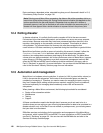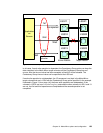134 IBM System Storage DS6000 Series: Copy Services with IBM System z
13.1 High availability solutions
Because the disk subsystem attached to the server is being mirrored using Metro Mirror, this
offers some improved opportunities for high availability solutions.
13.1.1 GDPS HyperSwap Manager
The GDPS services offering includes the GDPS HyperSwap™ Manager function. This
function can be used to mask some primary Metro Mirror disk subsystem problems or
planned maintenance activities, by allowing the primary DASD to be swapped transparently
from one site to another without requiring an application or system outage. For more
information, refer to Part 8, “Solutions” on page 431.
13.1.2 Open systems - Clustering
For open system environments, IBM offers several solutions in this area, including GDS for
Windows environments, and HACMP™ for AIX. For more information, refer to Part 8,
“Solutions” on page 431.
13.2 Failover and failback
The Metro Mirror Failover and Failback modes are designed to help reduce the time required
to synchronize Metro Mirror volumes after switching between the production and the recovery
sites.
In a typical Metro Mirror environment, processing will temporarily switch over to the Metro
Mirror secondary site upon an outage at the primary site. When the primary site is capable of
resuming production, processing will switch back from the secondary site to the primary site.
At the recovery site the Metro Mirror Failover function combines, into a single task, the three
steps involved in the switch over (planned or unplanned) to the remote site: terminate the
original Metro Mirror relationship, then establish and suspend a new relationship at the
remote site. Note that the state of the original source volume at the normal production site is
preserved. The state of the original target volume at the recovery site becomes a source
suspended. This design takes into account that the original source LSS may no longer be
reachable.
To initiate the switch back to the production site, the Metro Mirror Failback function at the
recovery site checks the preserved state of the original source volume at the production site
to determine how much data to copy back. Then either all tracks or only out-of-sync tracks
are copied, with the original source volume becoming a target full-duplex. In more detail, this
is how Metro Mirror Failback operates:
If a volume at the production site is in the simplex state, all of the data for that volume is
copied back from the recovery site to the production site.
If a volume at the production site is in the full-duplex or suspended state and without
changed tracks, only the modified data on the volume at the recovery site is copied back to
the volume at the production site.
If a volume at the production site is in a suspended state and has tracks that have been
updated, then both the tracks changed on the production site and the tracks marked at the
recovery site will be copied back.
Finally, the volume at the production site becomes a write-inhibited target volume. This
action is performed on an individual volume basis.


















